
‘The Moor of the Delaware’
[with apologies to W. Shakespeare]
One thing can be said for the ‘Dragon .
. . they are THOROUGH !!
A couple of weekends ago, we had the annual ‘Mooring
Meeting’ for all members who will be putting a boat in
the water. It is for BOTH new members who don’t yet have
any ground tackle, and for the ‘old salts’ to review
& ‘overhaul’ what they already have. For some
people, this means the last time they will see this stuff for
some time - the Club is initiating a new policy of a three-year
‘cycle’. That is, 1/3 of the field will be pulled
at the end of the sailing season. It will be placed ‘on
the hard’ for inspection prior to being ‘re-set’
the following spring. The remaining 2/3rds will remain in place
for that winter, and so on.
While there are plenty of ‘old salts’ at the Club
{one gentleman will shortly be 100 years old, and a member for
over 60 years . . . and still sails !!}, there are a few ‘youngsters’
like me, too. When Joanne & I got our ASA Certification,
maybe 10 years ago, one of the ‘permanent mooring’
options discussed was the simple expedient of dropping an old
engine block over the side with an appropriate length of chain
looped through it. Did I get a surprise when I said that last
year !! And my idea to use a cement-filled car wheel to ‘simulate’
a mushroom also got, ‘blown out of the water’. Fortunately,
I did get a ‘pass’ on requiring a 250 pound minimum
for my 19-foot, 1200 pound boat. Oddly enough, now, between
the two anchors, and the ½ inch ‘bottom chain’,
I do have 250 pounds, plus, ‘on the bottom’. One
of the things I pointed out {they are using ‘Chapman’s
‘ as their ‘bible’} was that the criteria
was for a Long Island, NY yacht club and 60 mph winds. A lot
more ‘fetch’ and ‘unprotected’ compared
to here in the Delaware River. {Just to see if I had put my
foot in it, I checked my copy at home . . . Manhasset Bay
Yacht Club, Port Washington, L.I. and 75 mph winds}. My
copy was from 1959 {when I got my 15-foot fiberglass ‘runabout’
with the 35 Evinrude !!} and I think the Harbormaster’s
was maybe 10 years ‘younger’. Also, we have maybe
33 ‘spots’ as opposed to the 200 in the example.
Anyway, while last year the requirement was for ½
inch ‘bottom chain’, now it was for no more than
3/8 inch. Nobody was saying anything about getting older, but
that the floating ‘A’- Frame hoist was having trouble
handling the weight !! Being on the crew that built the new
and ‘rebuilt’ the old docks, they looked pretty
sturdy to me !! {Turned out each ‘dock’ section
weighed 2,000 pounds, and the ‘A’-Frame weighed
4,000!}
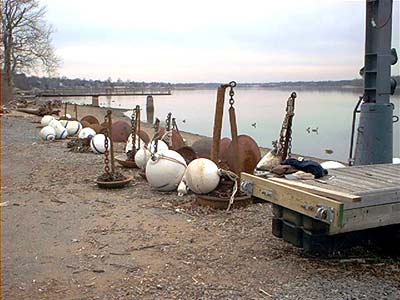
It’s really something to see - all that ‘steel’
up on the hard, along the seawall . . . and so many different
kinds. Yesterday we ‘launched’ and assembled the
‘Floating Docks’ for the season. The rented crane
had the capability of weighing the lift. He moved one of the
‘railroad car wheel’ moorings . . . 900 pounds !!
With the 3/4inch bottom chain, etc - there was about 1200 pounds
holding that one boat !! It’s going to be a lot of fun,
moving that load with ‘human power’, next week when
we set the moorings for the season.
Reading this far, especially the last paragraph, you can see
there has been some ‘decline’ in mass, and ‘upgrade’
in technology. While the physical weight has decreased, the
‘holding power’ has either stayed the same, or actually
increased. That ‘super-heavy’ train-car wheel can
actually be LIFTED off the bottom by the boat it is
supposed to hold !! The Club is on a river with a tidal stream
. . . is back & forth on one plane. Anchors have been ‘wrapped’
by their chain, and the ‘tide swing’ has lifted
the boat - AND ANCHOR - up to 7 feet . It is then moved at the
whim of the tide and wind. So much for ‘dead weight’.
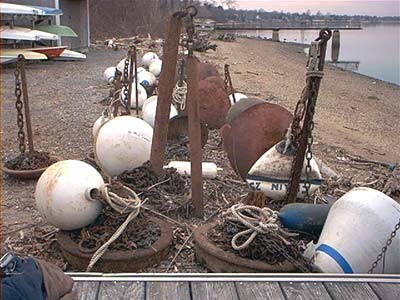
Without getting into some really specialized anchors {like
the ‘Helix’ or ‘Pyramid’ - which require
a diver to burry them, and annual dives to inspect & maintain
the guarantee}, there are some techniques & modifications
to the classic ‘Mushroom’ that do very nicely. To
the ‘non-sailor’ {non-boater ? } it may seem to
go against logic, bit the idea/concept is to ‘set’
the mushroom anchor, ‘on edge’. This lets the circular
edge, with help from gravity, tide, and currents, bury itself
in the bottom. This will give maximum hold. A ‘double-set’
with anchors at both ends of a proper length of ‘bottom
chain’ are even more ‘set’ and stable. The
‘riding chain’ is attached to the middle and any
pull actually helps to set them deeper.
What is ‘needed’ to make this work is that the
shaft be as flat as possible along the bottom. This stops the
anchor from ‘popping up’, where it can be wrapped
& ‘hoisted’. It also helps to prevent the bottom
chain {from a ‘single set’} getting caught. The
upraised, rounded, circular bottom allows the chain to slide
over from the other direction. The main trick is helping that
shaft to lie down. Granted, you have attached about twice the
water depth with bottom chain {with safety wired shackles &
‘eye to eye’ swivels}. However, a little ‘insurance’
is nice. ‘Modern’ mushrooms have a cast-or-welded
in extra weight
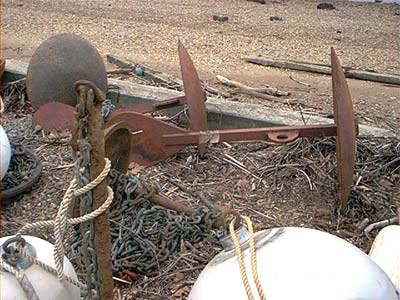
Note also the hole that serves as a balance & lifting
point - so the anchor is dropped ‘on edge’. {the
‘old style’ are now required to have a shackle attached
to the ‘lip’}
Another way is to attach a weight to the end of the shaft
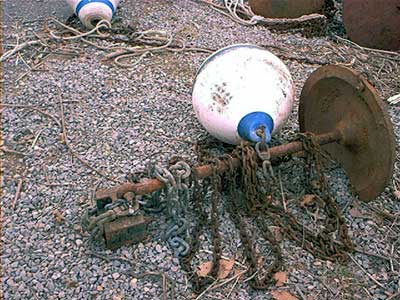
Another way, if your cheap and have access to a welder, is
to add weight to the shaft. This is the heavier of my dual anchor
set
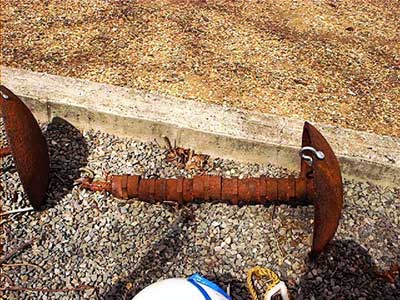
Also note the ½ in shackle I attached. There is a smaller
shackle on the ‘lighter’ anchor at the other end
of 66 feet of bottom chain.
The ‘other end’ of the rig also deserves a LOT
of attention . . . some even recommend ANNUAL replacement. This
is the end that is exposed to sunlight and the sudden strains
& jerks of boat movement. The Club recommends ‘doubling
up’ the pennant that attaches the boat to the mooring.
{The size of the Buoy depends on the length of ‘riding
chain’ which attaches to the ‘bottom chain’
with shackles & eye swivels at BOTH ends, and a shackle
& ring to the buoy}. A very good thought. Us Nylon line
{or some other material with stretch}. While my ‘primary’
is 3/8th Nylon, the ‘back-up’ is ½ Polypropylene
- bright yellow and it floats. It is also about 6 inches longer
than the primary. While they can be bought, ‘ready made’
it’s a good idea to learn how to make your own. I’m
trying Nylon ‘thimbles’ because there has been some
discussion about the galvanized ones chafing the line. This
is where YOUR boat is attached . . . While it is also the weakest
link, it is the easiest to continually inspect.
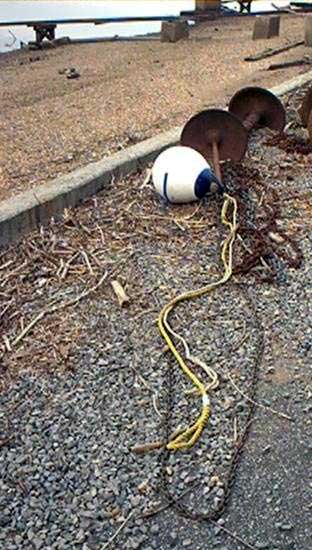
The Coast Guard requires a ‘White float, with a Blue
band’ for use on a mooring, other than that it’s
the owner’s choice. Some guys let the line just float,
others tie the two together, and some use brightly colored ‘Swim
Noodles’. For us, a ‘pick-up’ buoy with a
4-foot ‘mast’ looks real ‘Yacht Club’.
Regards,
Ron Magen
Backyard Boatshop
PS - ‘Comments & Discussion Welcomed’

